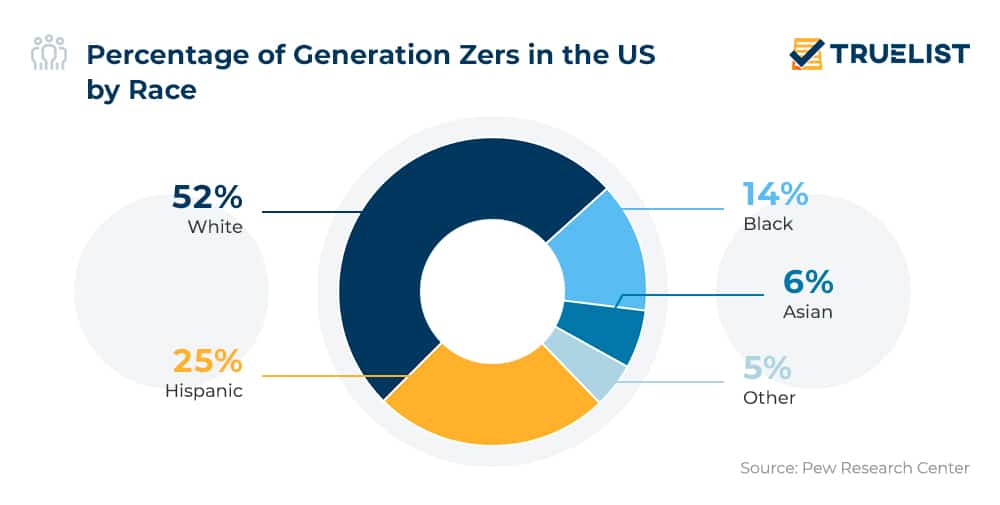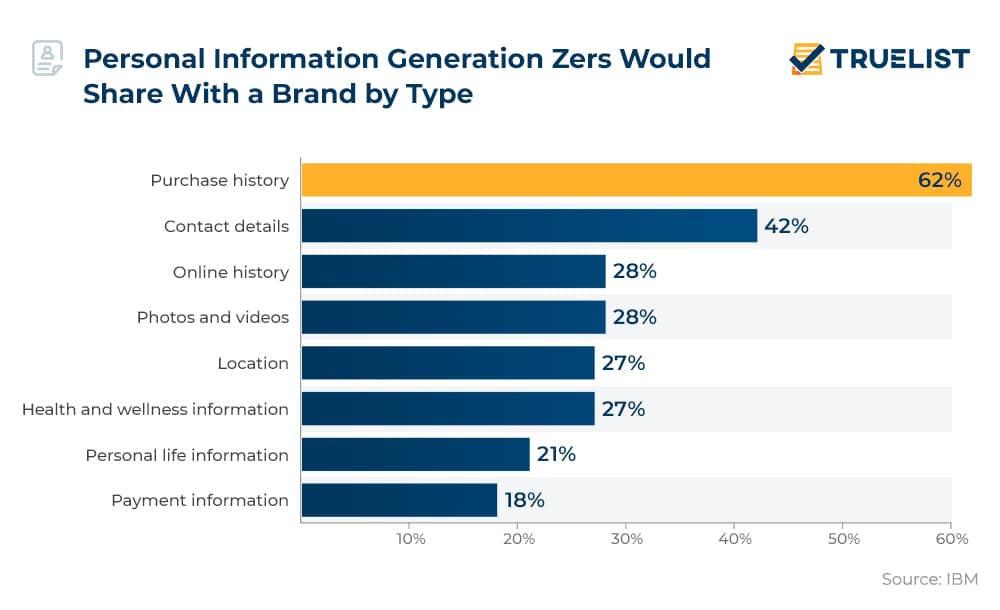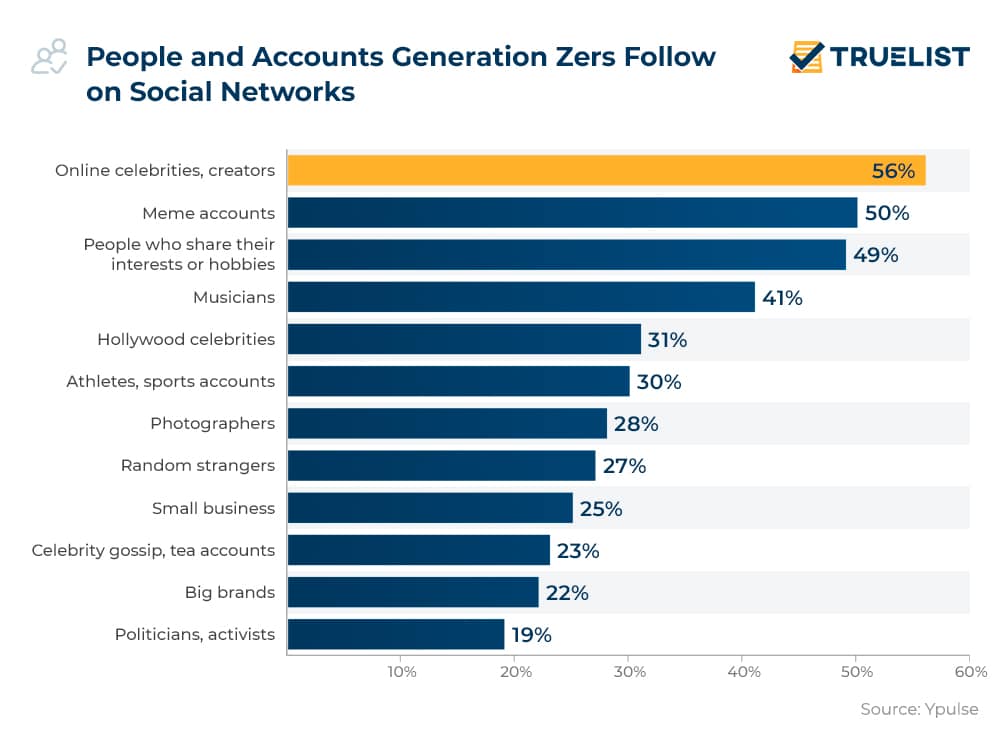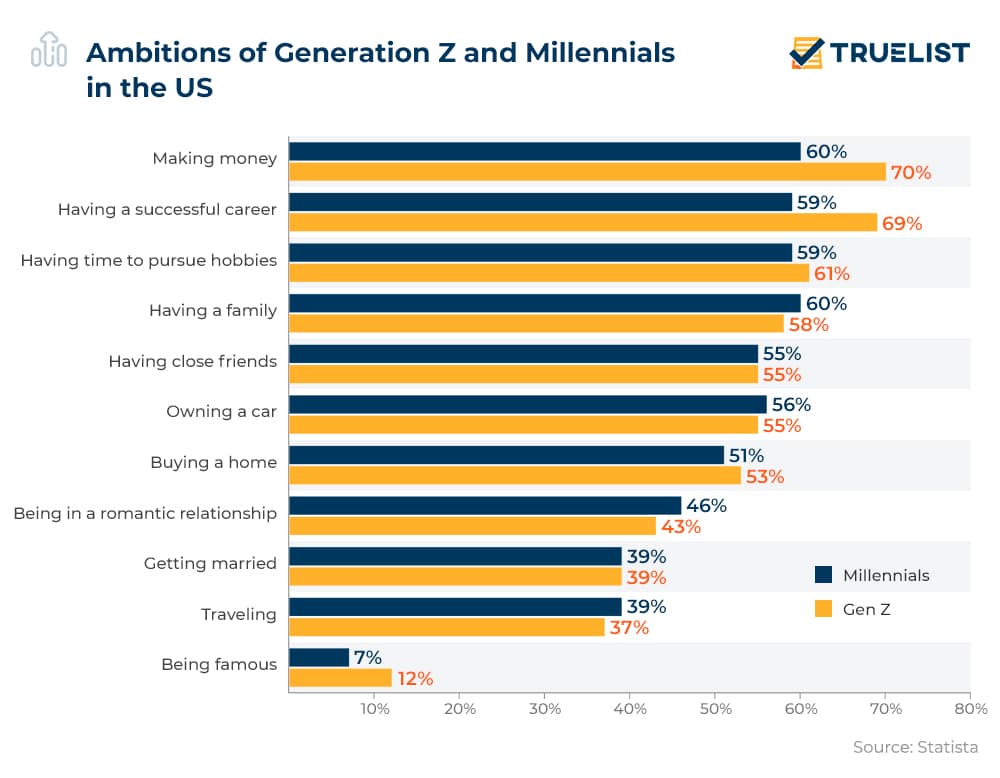While Millennials are still regarded as the most powerful age group by many, Generation Z has started moving into the consumer spotlight and mind you, they have their own set of preferences which significantly influence consumption patterns. We’ve prepared these powerful Generation Z statistics to help you craft your marketing strategy for this distinctive demographic bunch whose importance is currently on the rise. Read on to learn more about the interests, shopping habits, and behavior of the generation that has grown up with digital technology.
Generation Z Statistics (Editor’s Choice)
- Gen Zers make up 26% of the global population. (Issuu)
- In the US, Gen Zers are expected to account for 40% of consumers. (Business Insider)
- 55% of the Gen Z population chooses eco-friendly and socially responsible brands. (99designs)
- Gen Zers are projected to make a total of 27% of the workforce by 2025. (Mccrindle)
- A whopping 91% of the Gen Z population say technology would be a decisive factor for choosing a job. (Dell)
- 97% of all Generation Z individuals learn about new products from social media. (Forbes, Ypulse)
- 58% of Generation Zers would want to have a good work-life balance. (Issuu)
- 53% of Generation Zers bought something through a mobile device in the last six months. (HireRight)
Generation Z Statistics Rundown
1. Gen Zers make up 26% of the global population.
The Gen Z age group currently occupies a little over one-quarter of the global population. That translates to 2 billion Gen Zers worldwide, and data shows this already is the largest cohort alive. What is characteristic about the Generation Z population (individuals born after 1997) is that they are the first digitally native age group, i.e. they grow up with technology. Facts about Generation Z, therefore, show their expectations are high on the seamlessness of everything.
(Issuu)
2. Generation Z is the most racially and ethnically diverse age group in the US.
To put things into numbers, currently 61% of US millennials identify themselves as white while for Gen Zers, this percentage amounts to 52%. So, if you look at data on the Gen Z demographic profile, you will observe that one in four identifies as Hispanic, while that number with millennials stands at 17%. Gen Z statistics further show that 6% claim they are Asian compared to 4% of millennials. Interestingly, the percentage of millennials, Gen Zers, and Gen X-ers identifying as Black hovers around 15%. In any case, the US Census Bureau projects that by 2026 the majority of this generation will be non-white.
(Pew Research Center)

3. Nearly all Generation Z individuals worldwide own a smartphone.
As many as 98% of all Generation Zers worldwide own a smartphone, the GlobalWebIndex report confirms. Generation Z technology and social interest data reveals that 96% of this age group living in North America have phones. Gen Z statistics meanwhile show that only 52% consider them the most important device, while in the Middle East and Africa where 99% of Gen Zers own smartphones, 79% say it’s their #1 device to access the internet.
(GlobalWebIndex)
4. 41% of Gen Zers and millennials take action after seeing a sponsored ad.
One fourth of the younger population (Generation Z and millennials) immediately clicks on an ad after seeing it, 30% make an online purchase and another 20% make an offline purchase. What is even more interesting for marketers is that 59% of people that belong to this generation tend to click on ads and buy the products recommended to them.
(Criteo)
5. Generation Z statistics on screen time show 71% of all teens spend three or more hours per day watching video.
Google’s official statistics further indicate that just over half (52%) of all teens use messaging apps for over three hours a day. As many as 42% meanwhile spend three or more hours daily playing games. All these trends are made possible by bigger mobile devices with longer-lasting batteries.
(ThinkWithGoogle)
6. In the US, Gen Z is expected to account for 40% of consumers.
According to recent statistics about generation Z, this demographic cohort accounted for as much as 40% of US consumers in 2020. While it remains to be seen if this trend will continue throughout 2021, data conclusively shows that targeting post-millennials will be essential for the business success of any marketer. Plus, market surveys reveal that they currently command $143 billion in purchase power.
(Business Insider)
7. 43% of Gen Zers would participate in a product review.
Generation Z interests vary but it seems that one of the more peculiar facts about Gen Z is that this age group really enjoys reviewing products. In fact, 43% of individuals would gladly participate in a product review, and another 42% would play an online game for a campaign. This means that they want to voice their opinion and build engaging conversions about brand relationships more than any other generation.
(NRF)
8. Less than one-third of Generation Zers are willing to share information regarding their private life with a brand.
While willing to have their voice heard, Gen Zers seem to value their privacy just as highly. According to IBM’s Generation Z statistics, 21% share their private life information with a brand. After the Cambridge Analytica data misuse, the youngest generation is extra careful with the information it shares online, and branding agencies should take that into account.
(IBM)

9. 55% of the Gen Z population chooses eco-friendly and socially responsible brands.
This demographic group likes to stand for something else besides profits. 68% of them say they are very conscious about the role they play in the world and do their part in turning it into a better place for future generations. Other statistics about Generation Z as the do-gooders of the century reveal that 56% believe they are socially responsible, and more than half buy goods produced by eco-friendly and socially responsible brands.
(99designs)
10. Over 70% of Gen Zers influence their family purchasing decisions on food and household products.
More than 70% of surveyed individuals from this age cohort say that they influence their family’s purchasing decisions. So, Generation X abides by the wishes of their kids and buys the recommended products frequently. It seems like Gen Zers know what’s best and cool, and their parents are inclined to listen.
(IBM)
Generation Z in the Workplace Statistics
11. Gen Zers are projected to make a total of 27% of the workforce by 2025.
Yes, folks, by 2050, post-millennials will make up almost 30% of the global workforce and, as a digitally native demographic group, they will have no problem keeping up with the digital market growth. Forecasts suggest that the Gen Z group will work a total of 18 jobs across six careers in their lifetime and will more or less change 15 homes.
(Mccrindle)
12. 44% of Generation Z aged 7 to 17 live with a parent who has at least a bachelor’s degree.
Generation Z education statistics demonstrate that as much as four out of ten people of this generation have been raised by a parent with higher education compared to 33% of Millennials who have had the same privilege. Pew Research Center’s survey says this generation is on track to be the best-educated generation yet. And it’s not just because almost half of them are living with a parent who had a bachelor’s degree or higher education but a little over half aged 18 to 21 are already in college.
(Pew Research Center)
13. Generation Z in the workplace statistics confirm diversity in the workplace matters for 88% of this cohort.
This age group highly values positive work environments. The majority of Gen Zers (88%) see diversity as a major factor in a job. Not only marketers but employers too should focus on inclusivity if they want to tap this future major workforce source.
(Yello)
14. Health insurance is a top job requirement for 70% of Generation Z.
Generation Z statistics reveal that young people really care about having good health insurance with 70% naming it number one on their list of top three “must haves” when scouting for a job. Competitive salary is appreciated by 63% and is the second most important matter when applying for a job position while the third requirement, according to 61%, is a boss they respect and can rely on.
(PR Newswire)
15. A whopping 91% of the Gen Z population say technology would be a decisive factor for choosing a job.
Working with cutting-edge technology is a big deal for this young generation to such an extent that, as Gen Z statistics reveal, a massive 80% aspire to work only with such technology. A solid 80% of this generation strongly believes that technology and automation pave the way to a more equitable work environment. So if you’re a recruiter trying to gather the best of the best, try to use a ‘tech-first’ approach to appeal to this age group.
(Dell)
16. 77% of Generation Z individuals would be more than willing to act as tech-mentors to other colleagues.
Workplace statistics about Generation Z show that this age group struggles between tech-savviness and lack of soft skills with 52% claiming they feel more confident about their tech than their non-tech skills. Their tech-savviness is obvious with stats showing that 77% would gladly mentor a colleague about the latest tech developments. Implementing internships, jobs, or other similar programs would be a nice way for companies to help Gen Zers build their soft skills.
(Dell)
17. 58% of Gen Zers would want to have a good work-life balance.
Gen Z statistics about work-life balance conclude this generation is not so eager to invest their life in building their own business or start-up. Cushman & Wakefield’s survey further shows that the youngest population is very much financially driven and in pursuit of high wages so they can buy their own home and eventually start a family. But of course, for a generation with high social values family comes ahead of money with 58% saying they would choose a good work-life balance instead of a well-paid job.
(Issuu)
Generation Z Social Media Statistics
18. 97% of all Generation Z individuals learn about new products from social media.
It seems that social media is what influences this age group’s habits the most. For Generation Z, technology and social interest are very much connected. Still, Facebook remains one of the most popular social media regarding product discovery for all generations. However, when it comes to Gen Zers, studies show that 65% are more inclined to watch video content than other generations. 56% follow celebrities, 50% meme accounts, 49% people with the same interests or hobbies, and 41% follow musicians on social media.
(Forbes, Ypulse)

19. Generation Z social media usage statistics show a little over 60% check YouTube at least once a day.
Business Insider’s research on Generation Z’s social media habits shows that 62.48% of this age group really loves watching YouTube. The main reason is finding out news about their favorite show, game, or products. This presents an opportunity for marketers to showcase their products or services through YouTube video.
(CenterBeam)
20. Generation Z loves Instagram the most.
Instagram made its boom after Facebook acquired the platform. Today, as Generation Z social media usage statistics indicate, more than 64% of Generation Zers love to use Instagram on a daily basis. Of all social media, Instagram is most popular among teens in the US. Data further reveals that 51.29% of the youngest generation use Snapchat daily. After all, it was Snapchat that pioneered the famous Instagram stories and videos on their platform. And don’t forget those FaceFilters, they had them first.
(Business Insider)
21. Facebook is the fourth most used social media for Gen Zers in the US.
Generation Z social media statistics reveal that only 34% of all users from that generation log in on a daily basis to check what’s going on in their social circle. And while Facebook changed the world when it was introduced back in 2004, it seems this platform is not as appealing as other social media for individuals with the Gen Z demographic profile.
(Business Insider)
22. 77% of Gen Zers feel more positive towards brands that promote gender equality on social media.
According to Facebook-compiled Generation Z trends and facts, more than two-thirds feel more positive towards a brand or a media when they promote gender equality on social media. A little over 61% meanwhile say that they would pay more for ethical and sustainably-sourced products, underscoring the importance this age group puts on diversity, inclusivity, and building a better world.
(Facebook)
23. 60% of Generation Zers want to communicate more with businesses via messaging.
A Facebook-provided survey offers some interesting Generation Z statistics suggesting that this generation highly values personal interactions, with 60% of responders confirming they wish to communicate more with businesses via messaging. The social network’s research further shows that brands can attract post-millennials by offering behind-the-scenes content or exclusive experiences.
(Facebook)
24. The majority of Generation Zers (82%) consider social media a valuable tool in the workplace.
For people who fit the Gen Z demographic profile, social media are more than just a way to socialize or spend money. According to Generation Z statistics, social media are considered a valuable workplace tool by a staggering 82%. Companies employing a significant number of Gen Zers, therefore, could do well to consider the usage of tools like social media messaging or campaigning in addition to AR and VR.
(Dell)
Need-to-Know Differences About Generation Z vs Millennials
25. Generation Zers have only 8 seconds of attention span.
Interesting millennials and Gen Z facts reveal that at 12 seconds, Millennials’ attention span is 4 seconds longer than that of the younger generation. What does this mean for marketers? When creating your ad, regardless of whether it is a video or a post, you must convey your message more directly, because young users will scan it for only a few seconds before closing it.
(Iab UK)
26. 53% of Generation Zers bought something through a mobile device during the six months before the survey.
When it comes to spending habits, generation Z statistics confirm more than 50% of teens prefer to shop on mobile which further proves that this generation lives on their phones. Millennials meanwhile are not so dependent on mobile platforms and still show high preference to visit a brick-and-mortar store, with only 37% having opted to purchase something online within six months.
(HireRight)
27. 70% of Generation Z thinks that making money is important while only 12% believe that being famous is also essential.
According to Statista’s Generation Z facts, 70% of post-millennials see making money as a priority for their future, compared to 60% of millennials who prioritize the same thing. On the other hand, the same study reveals that 12% of the younger generation would want to be famous, as compared to 7% of millennials that feel that way.
(Statista)

28. 59% of Gen Zers have enrolled in college as opposed to 53% of millennials.
It seems the younger generation is keener on learning and less likely to drop out of school. Education facts about Generation Z reveal only 6% of them did not complete their high school education. In contrast, the number of millennials who dropped out of high school is somewhat higher at 12%. In addition, nearly 60% of 18-20-year-olds enrolled in college with the intention to graduate while the percentage of millennials enrolled in college stands at 53%.
(Signal Vine)
29. 16% of millennials and Gen Zers say the cost of education is one of their main concerns.
The latest Generation Z education statistics indicate that although both generations are equally concerned about how they would manage paying for their education, with a total of 21%, Gen Zers appear to be more stressed about the matter. A Generation Z vs millennials comparison reveals that in relation to Gen Zers, one out of ten millennials is concerned about the cost of education.
(Career Enlightenment)
FAQ
What is the Generation Z age range?
Generation Z is the generation that came after millennials. The members of this age group are individuals born between 1997 and 2012, and are often the kids of Generation X. Nevertheless, different sources tend to define Generation Z age range differently.
(Beresford Research)
What percentage of consumers are Gen Z?
Generation Z has become about one-third of the global population. So, out of about 7.4 billion people in the world, 2.56 billion belong to Generation Z. In the US, NPD data shows that this age group accounts for a staggering 40% of the nation’s consumers.
(Forbes, NY Post)
What are the values of Generation Z?
Freedom to express their thoughts is essential to Gen Zers. There are indications that post-millennials, as they are sometimes referred to, care about the world. This age group is more environmentally conscious than its predecessors, and highly values diversity, and demands it from brands and employers alike.
(Extreme Reach)
Conclusion
As one generation of consumers shifts to another, so must your marketing strategies. While millennials are still here to stay, the Generation Z population is slowly but surely taking over the consumer market. The Generation Z statistics we presented in this article have hopefully helped you understand this tech-savvy generation better, enabling you to craft more effective marketing messages targeting this powerful group of consumers.
Sources: Issuu, Business Insider, 99designs, Mccrindle, Dell, Forbes, Ypulse, HireRight, Pew Research Center, GlobalWebIndex, Criteo, ThinkWithGoogle, NRF, IBM, Yello, PR Newswire, Dell, Business Insider, Facebook, Iab UK, Statista, Signal Vine, Career Enlightenment, Beresford Research, Forbes, NY Post, Extreme Reach

